Reports
Performance of the IR-1 Centrifuge at Natanz
by David Albright and Christina Walrond
October 19, 2011
During the past year, the performance of the IR-1 centrifuges at the Natanz Fuel Enrichment Plant (FEP) has faltered. Although the average monthly production of 3.5 percent low enriched uranium (LEU) has increased to about 150 kg/month, the number of centrifuges needed to produce this LEU has increased disproportionately compared to the previous year. During the last year, Iran has needed 5,860 IR-1 centrifuges to produce this amount of LEU. In the previous year, it would have needed only about 4,820 IR-1 centrifuges to make this quantity of LEU.
<
p> It is widely known that the IR-1 centrifuge, based on the Pakistani centrifuge called the P1, is not a reliable centrifuge. The P1 centrifuge was derived from a Dutch design that also suffered excessive machine breakage. The new performance data suggests that Iran has not succeeded in overcoming these design problems.
<
p> Ten years after the start of construction at the Natanz enrichment site, the probability that Iran will build tens of thousands of IR-1 centrifuges seems remote based on their faulty performance. According to experts close to the International Atomic Energy Agency (IAEA), because of sanctions, Iran is also facing a shortage of a key material, maraging steel pre-forms needed to make IR-1 bellows, sharply limiting the number of IR-1 centrifuges it can make.
<
p> Rise and Fall of IR-1s at the FEP
<
p> The number of IR-1 centrifuges installed at the FEP climbed steadily to a peak of almost 9,000 in November 2009 before falling in late 2009 or early 2010 ostensibly due to the effects of the Stuxnet malware. Currently, the number of installed centrifuges has leveled off at around 8,000.
<
p> The number enriching, i.e. being fed with uranium hexafluoride (UF6) gas, reached 5,000 IR-1 centrifuges in the spring of 2009, before decreasing to less than 4,000 in late 2009 or early 2010, a development likely related to the Stuxnet malware. This number started to increase again in late 2010. By late 2010 or early 2011, about 6,000 IR-1 centrifuges were enriching, and this remains the current value. However, the IAEA has noted during the last two Iran safeguards reports that not all the centrifuges in the cascades being fed with uranium hexafluoride may be enriching.
<
p> Figure 1 summarizes this discussion, showing centrifuge trends since the beginning of operations at the FEP, with the dark green bar indicating the number of centrifuges being fed with uranium hexafluoride, and the light green bar displaying the number of centrifuges installed.
<
p>
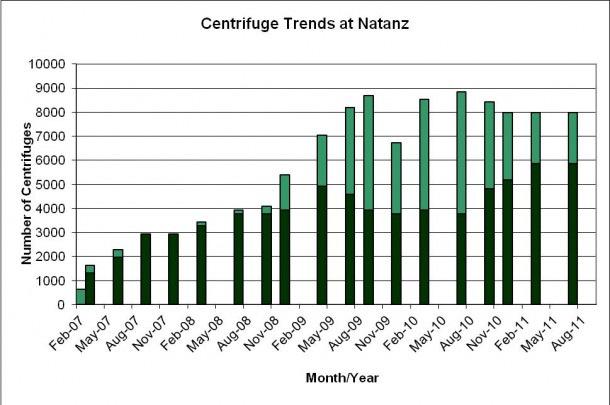
<
p>
<
p> Measure of Performance: Product to Feed Ratio
<
p> An indicator of the overall performance of the IR-1 centrifuge cascades at the FEP is the ratio of the amount of product extracted from a cascade to the amount of feed introduced into that cascade, or the “product to feed ratio.” Based on Iran’s statements about the operations of the cascades at the FEP, Iran should expect to achieve a ratio of approximately one kilogram of 3.5 percent LEU hexafluoride product for every 10 kilograms of natural uranium hexafluoride that is fed into the cascades. Moreover, this ratio should be stable during operation. In practice, it has not been able to exceed a ratio of one to nine. The data show that initially the enriching cascades experienced a low feed to product ratio, but this would only be expected as Iran started operations.
<
p> In early 2010, Iran’s product to feed ratio reached a peak. Since then, it has decreased gradually. During the last year, the FEP’s product to feed ratio has decreased to about one kilogram of 3.5 percent LEU to 13 kilograms of natural uranium hexafluoride, based on data collected by the IAEA. In other words, Iran must feed more natural uranium to produce a given quantity of 3.5 percent LEU product.
<
p> Figure 2 shows the cumulative product to feed ratio at the Natanz FEP. Looking at a cumulative value, which evaluates total amount of product produced to that date divided by the total amount of feed, provides a longer-term trend in this ratio. The decrease in the product to feed ratio during the last year is visible as a decrease in this graph. This recent effect is easier to see in figure 3, which charts the product to feed ratio in individual three month reporting periods. The last data point from September 2011 represents one year of data.
<
p>
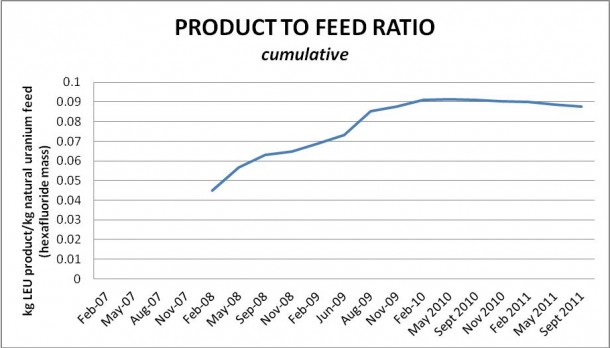
<
p>
<
p>
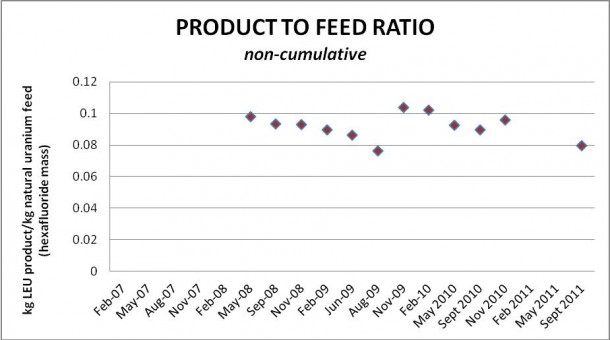
<
p>
<
p> The ratio in October 2011 in figure 3 is approximately equal to the ratio in the summer of 2009, right before Stuxnet is thought to have infected the Natanz plant. This malware led to the destruction of about 1,000 centrifuges in the FEP and Iran turning off many more centrifuges. Afterwards, this ratio increased to above 0.1. One interpretation of this increase is that the centrifuges which continued to enrich after the Stuxnet infection had already been functioning better than the ones affected by the malware. The ones infected by the malware were in a newer module, while the better performing ones were mainly in the first module built at the FEP. As Iran recovered from the attack and brought these affected cascades in the newer module back into operation, the ratio dropped again.
<
p> An alternative method to understand this reduced performance is to consider figure 4. If the FEP were operating optimally at a product to feed ratio of one to ten, the UF6 feed (red line, secondary axis) and the LEU product (blue line, primary axis) would overlap. However, over the past year, the distance between the lines has increased.
<
p>
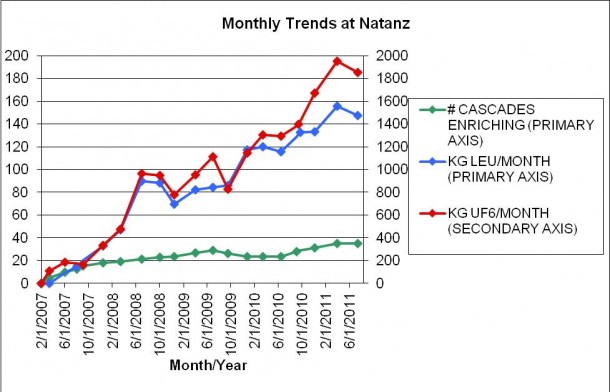
<
p>
<
p> This means that an excess of feed has been introduced into the cascades at the plant. This extra feed is not believed to have been lost in the plant in the form of hold-up, for example. But much of this excess could have ended up in the dump tanks, which receive both enriched and depleted uranium evacuated from the cascades when the centrifuges suffer difficulties such as excessive vibration or breakage. The enriched uranium hexafluoride is sent to the dump tanks to prevent it from diluting the 3.5 percent LEU in the product tanks.
<
p> Measure of Performance: Average Enrichment Output per Centrifuge
<
p> Performance can also be measured by charting over time the average separative work per year per centrifuge (swu/year-centrifuge). Although these data do not include the separative work in the slightly enriched uranium in the dump tanks, they do provide a comparative method to chart Iran’s output of 3.5 percent LEU, averaged over all the enriching centrifuges.1 These data also indicate problems during the last year with the performance of the cascades at the FEP.
<
p> Table 1 shows the historical data for the average separative work for centrifuge at the FEP. As is evident, the average swu/year-centrifuge has fallen from approximately 0.92 at its peak in the winter of 2010 to approximately 0.74 swu/year-centrifuge as of the last reporting period, which ended in August 2011. Iran would probably like to achieve an optimal average enrichment output of about 1.0 swu per year per centrifuge. Figure 5 shows the equivalent separative output of the FEP, based on its output of 3.5 percent LEU.
<
p>
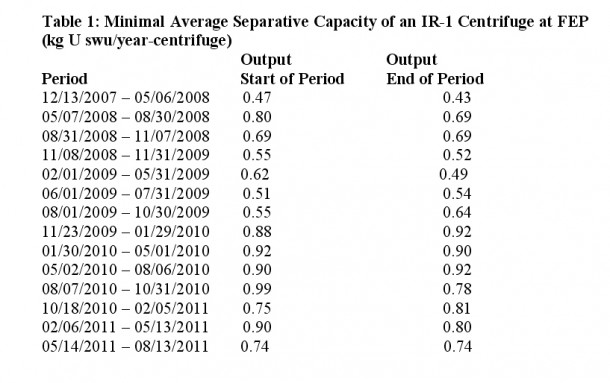
<
p>
<
p>
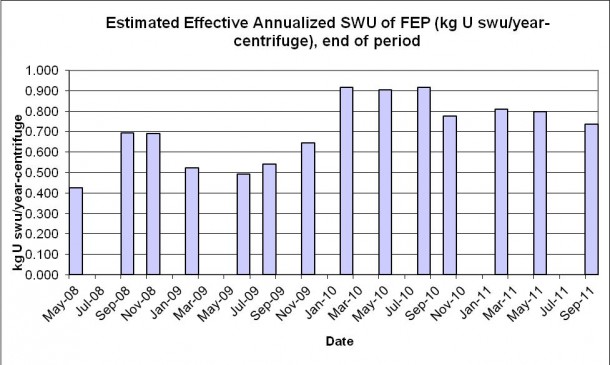
<
p> Causes of Poorer Performance
<
p> It is likely that multiple factors have played a role in the diminished effectiveness of the FEP during the past year. The available data are too general to determine the actual situation.
<
p> As discussed above, the effect could be partially due to problems in the newer cascades installed at the FEP. Another factor could be that the older centrifuges are starting to age and experiencing increased centrifuge breakage. Many of the IR-1 centrifuges are approaching five years old now and early generation machines would not be expected to last many more years. It is also possible that the Stuxnet malware decreased the lifespan of many machines by causing them to spin at altered speeds, even if the malware did not cause them to break immediately. The high rates of breakage also may also indicate that Iran has not mastered the manufacturing of these centrifuges, as they must be machined to extremely high specifications.
<
p> Regardless of the reason for the FEP’s increased inefficiencies, ten years after the start of the FEP’s construction, most would rate the FEP as a failure from a commercial point of view. It is unlikely to ever produce enough LEU for a nuclear power reactor the size of the Bushehr power reactor.
<
p> These problems help explain Iran’s decision to build advanced centrifuges. However, Iran’s schedule for deploying its new IR-2m and IR-4 centrifuges as well as for their location remains unclear. Will they be deployed at the Natanz FEP, the Fordow enrichment site, or elsewhere? Moreover, sanctions are reportedly hindering Iran’s ability to build many thousands of advanced centrifuges, the number necessary to operate enrichment on a commercial level. As a result, even with advanced centrifuges, Iran may be blocked by sanctions from building advanced centrifuges in large enough numbers to supply LEU to a commercial nuclear power reactor.
<
p> Faced with these uncertainties, Iran is increasingly dedicating its 3.5 percent LEU to the production of 19.75 percent LEU. Its current output of 3.5 percent LEU at the FEP matches its stated feed requirements to make 19.75 percent LEU. But it now has more than enough 19.75 percent LEU for its civilian research reactor, and its claims of building 4-5 more research reactors ring hollow. So, the question becomes: is the Iranian enrichment program on a trajectory toward being dedicated to producing weapon-grade uranium for nuclear weapons? Unfortunately, despite its severe limitations, this program is able to do so.
<
p>
1 The amount of separated work in the slightly enriched uranium in the dump tanks is estimated to be about ten percent of the total separative work.
<
p>

 twitter
twitter